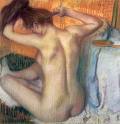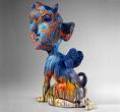
 |
 |
 |
 |
Fine Art And Collecting Reviews
African American Fine Art And The Harlem Renaissance
African American Fine Art And The Harlem Renaissance
Fine art collecting is a major industry as well as a hobby today, purely and simply because of the sheer amount of money that is poured into the arts as a result of it. New talented artists develop as a eventuality of the hunger for good art today, and that can only be a good thing because those individuals are carrying on the work of the past artists that they aspire to be like. In no race is that more easy than in the African Americans. Past artists did their best to establish a cultural identity away from that imposed on them by whites in the latter part of the 19th Century and earlier part of the 20th Century, and young artists are now establishing their own identity. It is fair to say though, that the Harlem Renaissance established an African American identity that other artists could follow.
The era of the Harlem Renaissance, 1920 - 40, is one of the most renowned pressure black art history, and effectively defined as a political, social and cultural beginning in art for mortals that may not have had their voices heard otherwise. As a product, terms such as identity, heritage and cultural consciousness are frequently mentioned, especially concerning cultural, racial and gender boundaries at this time. However, each commentator seems to have a unique perception of these boundaries - where they were, what they meant and the impact they had on black society during this era. This mirrors the attitudes of the artists of the 1920 - 40 period. The era produced diverse African American work because of their unique perceptions on how best to represent and advance the race - whether it was looking for cultural roots in Africa, portraying modern city life or exemplifying witting members of the race. No one view of the world was the same, even if there were certain common themes to represent found between artists.
Artists like Archibald Motley Jnr, Lois Mailou Jones and Doris Ulmann all played a part in ensuring that the African American voice was heard in this period and then continued afterwards to stabilize the boundaries that they had already set. The art that was produced character this period can certainly be considered as fine art and is now displayed in some of the most visited museums network the world. They arguably began the tradition of African American fine art that continues today and effectively broke into a previously white dominated cultural industry back prestige their day, although some artists did not get the worship that they fit accordingly.
Ullman and other individuals like James Front rank Der Zee are not artists in the traditional sense of the microcosm but still challenged boundaries like Motley and Mailou Jones. They were photographers and thus it can be argued that their work is not exactly fine art, but within modern boundaries the majority of individuals associated with the arts would accept their work as fine art now. Their photographs are truly astonishing and most yes works of art.
The era of the Harlem Renaissance was anything but a failure, as some critics obtain tended to brand it in the past. It built a stable element for future African American artists to build upon, and these four artists contributed to that foundation in numerous ways, and they certainly pushed back gender and racial boundaries thus paving the way for a change in attitudes concerning black artists and society in general. In terms of the modern day, their fine art is almighty collectable because of this and that fact alone, without side of the political and cultural connotations associated with it, made sure that the fine art of the Harlem Renaissance can be truly appreciated as great. It directly occupies its rightful place on the walls of museums all over the world, soon to be joined no doubt by some of the modern artists that have the same dreams of success that those artists did back then!
 |
 |
 |
The Art Of Detecting Forgeries
Using The Internet To Achieve The Art Collection Of Your Dreams
Essential Information On Protecting Your Artwork
The Top Ten Tips That Every Art Collector Should Know!
A Love Of Fine Art That Lasts A Lifetime
Everything You Need To Know About Galleries
Fine Art & Collecting Information At Your Fingertips
The Art Lover And The Art Collector
Dietary Supplements Information
Vegetarian Cooking Information
Vitamins And Supplements Information
Health And Fitness Information
More Fine Art And Collecting Reviews
Evolving From An Art Buyer To An Art Collector
... learning else about this fascinating avocation. Galleries commonly conduct seminars and discussion groups about the basics and the nuances of art collection. By keeping yourself informed of the language and the lay of the land of art collecting, you will avoid pitfalls many fall care and your enjoyment ...
Maintaining The Health Of Your Artwork
... frame it in an art tight frame that would be impossible to get through. If this is your more valuable of storage than make sure that it is reframed regularly to maintain the seal. In terms of cleaning, all pieces of art, whether sculptures, models, photographs, paintings or sketches, you need to be extremely ...
Passing The Love Of Art Collecting To The Next Generation
... to enjoy art collecting. If it is part of your life already, they no doubt have already picked up on your enthusiasm for the hobby and have an avid interest in art collection. If so, that is a great place to start. The next step is to start them on a step - by - step path to becoming art collectors themselves. ...
... undoubtedly a genre and an accepted specialized area in the arts today and has been for some time. Crack are museums all over the world filled to the rafters with fine art, and worthy fine art at that! But what exactly is fine art. There is an accepted definition but very few of us know it seeing we are ...

|
| Copyright © 2006-2012 Internet Marketing Tools, All Rights Reserved |